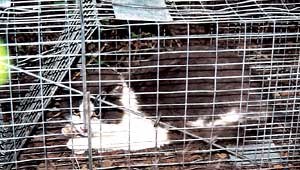Cats Inside!

An online resource for students of nature and the outdoors.
 Do you know where your cat is?
Do you know where your cat is?
Did you know that the average life expectancy of an outdoor cat is four years, and that indoor cats can live to be sixteen or older?
Each year thousands of outdoor cats are killed by cars or die from disease. Besides being at far greater risk of disease and injury than indoor cats, outdoor cats also have a major impact on native wildlife. Unlike most wild animals, even well-fed cats hunt and kill millions of songbirds, reptiles, amphibians and small mammals each year.
 Some free-roaming cats are feral. That means they are wild, either abandoned or born wild, and have no owner. Feral cats are a big problem because they are not cared for and can carry disease to your cat and reproduce more wild cats that often can't be tamed even if they are captured.
Some free-roaming cats are feral. That means they are wild, either abandoned or born wild, and have no owner. Feral cats are a big problem because they are not cared for and can carry disease to your cat and reproduce more wild cats that often can't be tamed even if they are captured.
We like cats, but the best place for pet cats is inside where they will be safe and healthy and live long happy lives. Also, that will allow the neighborhood wildlife to lead safer, healthier lives too.
Show you care about your pet and your environment by bringing kitty inside and find out how easy it is to make a difference in your world.
Things you can do to make kitty more at home inside:
- Toys - From paper bags and rolled-up balls of foil to motorized “mice” and laser pointers, toys liven up even the laziest feline.
- Scratching Post - Cats LOVE to scratch. It helps to remove broken claws, stretch muscles, and mark “territory.” The best way to save your furniture is to provide lots of “approved” places to scratch. Cat “trees” and posts, cardboard scratching boxes.
- Cat "TV" - a bird feeder placed near a window can provide hours of entertainment. If windowsills aren’t wide enough, build or buy a cushioned perch (available from pet supply catalogs) to attach to the sill. Note: Make sure windows are secure and won’t slide down on cats, and keep the cords of window blinds tucked out of the way so legs don’t get caught.
 Cat porches - A screened-in porch or an area adjoining a window is a great way for kitty to safely commune with nature. Make sure the mesh is small enough and high enough to securely keep kitty in.
Cat porches - A screened-in porch or an area adjoining a window is a great way for kitty to safely commune with nature. Make sure the mesh is small enough and high enough to securely keep kitty in.- Walk your cat - Yes, cats can be taught to walk on a leash—just be sure to use an ultra-lightweight, retractable leash attached to a harness, not a collar. Get your cat used to the harness for short periods indoors; then pick an open outdoor area to explore.
- Plant a garden - of catnip. Cats will nibble it and roll in it. Other healthy snacks are wheat grass, alfalfa, and oat grass (get seed-starter kits from companion animal supply stores).
Additional Information: